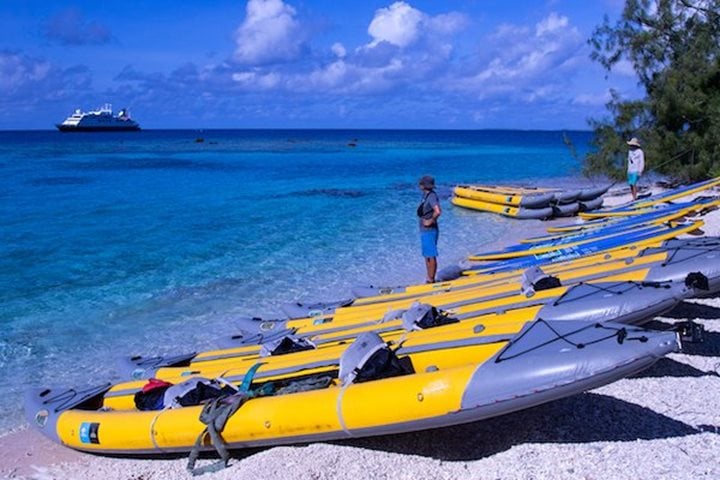We spent the day exploring both the marine and terrestrial worlds of
The island was discovered by Europeans in 1520 when Ferdinand Magellan, sailing on behalf of
Our expedition stop today lacked the desperation of Magellan’s visit so long ago, but we were no less excited to be here. We devoted the morning to activities in the gin-clear waters…SCUBA diving, snorkeling, and tours in the glass-bottom Zodiac. The upper-most region of the reef appears to have suffered from coral bleaching in the last couple years, because most of the short finger coral structures were coated with calcareous algae. However, from a few meters lower, the rest of the coral reef located on the slope is very healthy, with near total coral coverage dominated by platelet corals. The most common fishes in the shallows were black trigger fishes and various dark-colored surgeon fishes, but deeper waters held numerous larger predators, such as snappers, trevally jacks, and at least three species of sharks (blacktip reef sharks, whitetip reef sharks, and grey reef sharks). It is noteworthy that the species diversity of both corals and fishes have definitely decreased as we have gotten more remote and isolated from where we began this voyage in the Tuamotus of French Polynesia, but that is to be expected as demonstrated by the study of biogeography.
We made a landing soon after lunch onto the exposed reef flat, and then spent a couple hours or so exploring this densely vegetated island with an amazing, hard-packed coral rubble beach all around the outer edge. Some interesting sea turtle tracks were noted right near the landing, showing us that this must be an important breeding site for these beautiful creatures (at least one green sea turtle was seen earlier by some of the snorkelers). Those who went ashore this afternoon were able to walk on the beach and meander through the narrow band of tournefortia bushes that seemed almost as though they had been planted for someone’s pleasure. Most of the island is covered with coconut palms, including both mature trees and countless thousands of sprouted coconuts that have filled in most of the gaps between the trees. It was actually difficult walking over the coconuts that nearly covered the ground in some places. Inside the dense forest, we were able to view many white terns and black noddy terns perched or nesting overhead in the cordia and pisonia trees, as well as lots of tiny skinks crawling around the leaf litter. However, the most exciting creatures encountered onshore were the immense and somewhat creepy coconut crabs. These impressive beasts are the largest terrestrial arthropods on earth. They can tear open coconuts with their huge pincers! Many of us also enjoyed a walk/wade in the shallow reef water where several young black-tipped reef sharks, finger-lipped mullet, and a peppered moray eel were spotted in the large, open tide pools.







